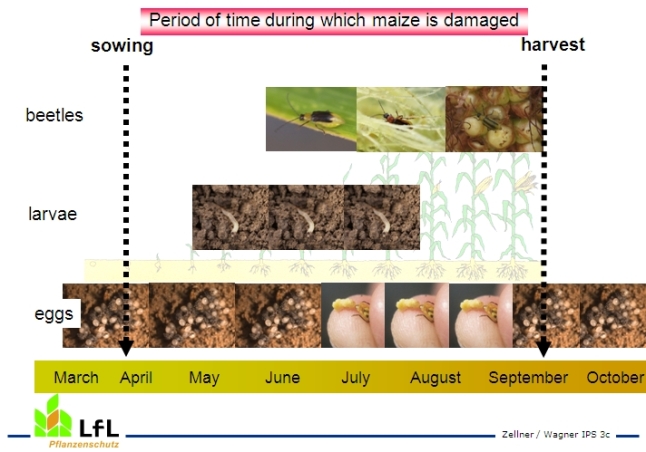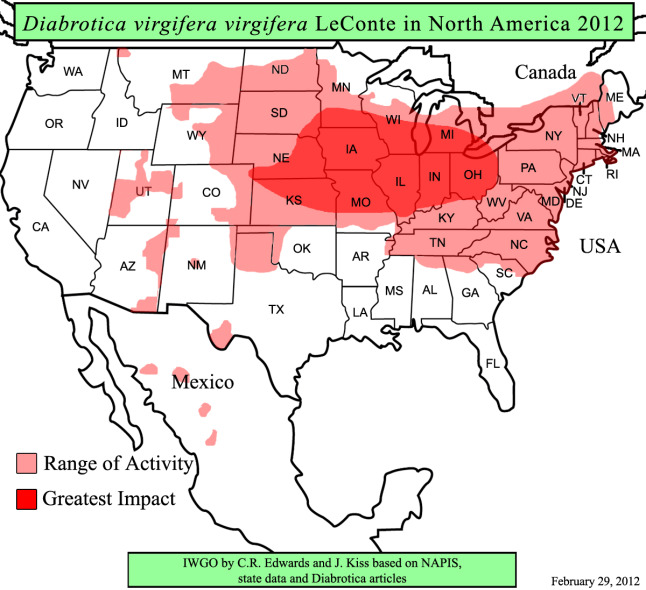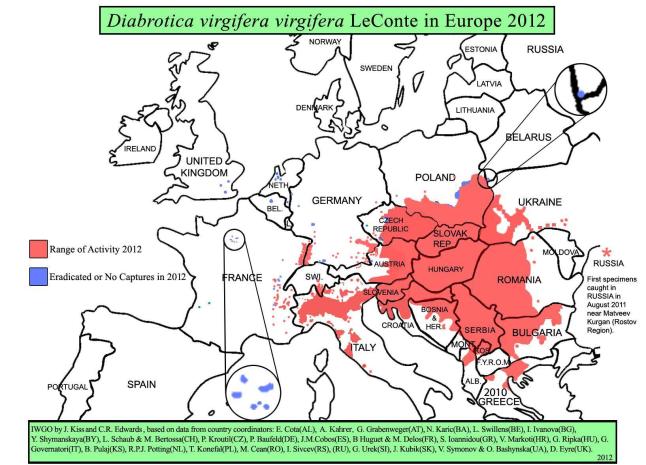
Western corn rootworm - a dangerous pest in maize cultivation
The Western Corn Rootworm (Diabrotica virgifera virgifera LeConte) is a leaf beetle belonging to the family Chrysomelidae. The beetles are about 5-7 mm long. Adults of the Western Corn Rootworm have a dark head, a yellow pronotum and a yellow abdomen. Their legs can be yellow or dark. The elytra are yellowish, often with three distinct darker stripes. Males and females differ to some extent in their markings. On males, nearly the entire posterior half of each wing cover is black (Fig. 1b), whereas on females, the dark stripes are more pronounced (Fig. 1a). Generally, males are smaller than females; they have longer antennae and are darker.
Development
Emergence and egg deposition
Western Corn Rootworm beetles usually begin to emerge from the soil in late June, and continue to emerge until late October (Fig. 1c-j). They are active in fields until frost. Female beetles lay 300-400 eggs in the upper 5-20 cm of soil among the roots of maize during later summer and early fall; with 80 % of the eggs in the upper 10 cm. The eggs are oval, beige and approx. 0.6 mm in size (Fig. 2a and b). Western Corn Rootworm eggs pass winter in the soil; a diapause of three to four months is necessary for the further development. Some of the Western Corn Rootworm eggs (0.21 %) may not hatch until the second spring due to "extended diapause", a resting period during which the insect does not develop.
Western Corn Rootworm beetles usually begin to emerge from the soil in late June, and continue to emerge until late October (Fig. 1c-j). They are active in fields until frost. Female beetles lay 300-400 eggs in the upper 5-20 cm of soil among the roots of maize during later summer and early fall; with 80 % of the eggs in the upper 10 cm. The eggs are oval, beige and approx. 0.6 mm in size (Fig. 2a and b). Western Corn Rootworm eggs pass winter in the soil; a diapause of three to four months is necessary for the further development. Some of the Western Corn Rootworm eggs (0.21 %) may not hatch until the second spring due to "extended diapause", a resting period during which the insect does not develop.
Larvae
Given German weather conditions, the first larvae hatch in the second half of May and the peak appearance is in June and July. In warmer countries (Italy), the hatching takes places much earlier. The larval development passes through three stages and is finished after three to four weeks. The size varies depending on the larval stage between 3-15 mm (Fig. 3a-c). When the larvae hatch they burrow into the developing roots and base of maize stems.
Given German weather conditions, the first larvae hatch in the second half of May and the peak appearance is in June and July. In warmer countries (Italy), the hatching takes places much earlier. The larval development passes through three stages and is finished after three to four weeks. The size varies depending on the larval stage between 3-15 mm (Fig. 3a-c). When the larvae hatch they burrow into the developing roots and base of maize stems.
Larval instars
Larvae at the first stage can move up to one meter in the soil to find a suitable food source (maize roots). After the larvae finish feeding, they change to the pupal stage in pupal cells (Fig. 4a-d) in which they change into the adult or beetle stage.
Larvae at the first stage can move up to one meter in the soil to find a suitable food source (maize roots). After the larvae finish feeding, they change to the pupal stage in pupal cells (Fig. 4a-d) in which they change into the adult or beetle stage.
Pupae
The whitish pupae are 3-4 mm in size (Fig. 5a and b). The pupal stage requires approx. seven days before transformation to the adult stage. Adults emerge from pupae in the soil and work themselves to the soil surface. Normally, males hatch before females.
The whitish pupae are 3-4 mm in size (Fig. 5a and b). The pupal stage requires approx. seven days before transformation to the adult stage. Adults emerge from pupae in the soil and work themselves to the soil surface. Normally, males hatch before females.
After emergence, the females feed for about two weeks before they start laying eggs. A female can have up to three periods of egg-laying. Each egg-laying period follows a period of feeding of two weeks and copulation. Nevertheless, the Western Corn Rootworm has only one generation per year (Fig. 6).

Fig. 6: Western corn rootworm life cycle
Origin and spread
The Western Corn Rootworm (Diabrotica virgifera virgifera) is a native of Mexico. During the 1950s the beetle invaded the USA, where it spread in the Corn Belt (Fig. 7a). It is widespread in North America and there it causes costs of more than one billion US dollar each year in agriculture due to yield losses and expenses for plant protection products.

Fig. 7a: Distribution in North America; Source: www.entm.purdue.edu/wcr/
The Western Corn Rootworm (Diabrotica virgifera virgifera) is a native of Mexico. During the 1950s the beetle invaded the USA, where it spread in the Corn Belt. There are hundreds of species of the genus Diabrotica. Important damages to maize are caused only by the Northern Corn Rootworm (Diabrotica barberi, Fig. 7b), the Southern Corn Rootworm (Diabrotica undecimpunctata howardi, Fig. 7c) and the Western Corn Rootworm (Diabrotica virgifera virgifera, Fig. 7d). Diabrotica virgifera virgifera is the only one which has established itself in Europe.
The Western Corn Rootworm was introduced from the USA to Serbia in the 1990s. D. virgifera was first detected in July 1992 near the Belgrade International Airport. Since its introduction, D. virgifera has been spreading in Europe and invaded other countries. In 2007, the pest was first detected in Germany, in Baden-Württemberg and Bavaria. In 2010, the first beetles were captured in North Rhine-Westphalia and in 2011 in Hesse and Rhineland-Palatinate.
In the neighbouring countries south-east of Germany, the beetle is established and population densities up to 50 beetles per plant can occur. The current infestation area of Diabrotica in Europe comprises Czech Republic and South-Poland in the north, Ukraine, Romania and Bulgaria in the East, Serbia and Bosnia-Herzegovina in the South, and Slovenia, Austria and Italy in the West (Fig. 8).
In the neighbouring countries south-east of Germany, the beetle is established and population densities up to 50 beetles per plant can occur. The current infestation area of Diabrotica in Europe comprises Czech Republic and South-Poland in the north, Ukraine, Romania and Bulgaria in the East, Serbia and Bosnia-Herzegovina in the South, and Slovenia, Austria and Italy in the West (Fig. 8).
In General, Diabrotica can spread in two different ways: natural spreading by active flight of the beetle and diversion by means of transportation.
The beetles are good flyers; they can cover single flights up to 20 km. In areas where intensive maize production (high amount of maize monoculture) is carried out, the average spreading rates expected reach 100 km. The natural spreading of Diabrotica in Europe can be significantly minimized by containment measures. Diabrotica can spread, even via continents, by hitchhiking by means of transportation like airplanes, trains, inland navigation, lorries and tourism. Very frequently, the first captures of the Western Corn Rootworm were in vicinity of airports, which proves airplanes as important transportation. In addition to being introduced from infestation areas in Southeast Europe, the Rootworm can also be reintroduced from North America at anytime.

Fig. 8: Diabrotica v. v. in Europe (2012) (Source: http://extension.entm.purdue.edu/wcr/)
Biological facts
The Western corn rootworm only has one generation per year. From July to September females lay up to 500 eggs into the soil where they overwinter. Larvae appear in the following year from the beginning of June on and begin to feed on corn roots at once. Whereas the first instar feeds on external fine foot hairs the second and third instar also burrows into roots. The roots’ ability to transport water and nutrients, as well as the stability of the maize plant are significantly affected. Also the roots are likely to get secondary fungal infections (root rot). Furthermore the plant tries to compensate the continuing loss of root mass by growing new ones, which drains a lot of energy. This in turn goes at the expense of developing aerial parts relevant for yield. If the weather is humid during this time, yield loss due to larval feeding stays under 30 percent in most cases. In years with dry weather during early summer, as last year in south-eastern Europe and at severe infestation, yield losses up to 90 percent are absolutely possible. After a pupation period of about a week, first beetles emerge in the maize fields from mid-July on. At first the beetles mainly feed on silks. If this feeding takes a great extent it may interfere with pollination and no or only few maize kernels can develop. But also feeding on leaf tissue leaving a window-pane appearance (comparable to cereal leaf beetle) is characteristic of Western corn rootworm beetles. Later beetles feed on kernels of milky ripeness or on other flowering plants, in particular on weeds. Towards end of September the egg deposition is ceased and the beetles die, starting with the first frost. Because larvae as well as beetles damage the maize plant, it is exposed to attacks from the Western corm rootworm from emergence to harvest, thus over the entire growing period. For one thing this explains the high damage potential that comes from this insect. For another it is apparent that with a high infestation pressure, as it can be expected about 5 years after the pests’ first occurrence, the pest can hardly be controlled only with chemical measures. Beyond that in monocultures the application of insecticides must be carried out every year. To make matters worse, in the USA the Western corn rootworm developed resistances against applied active ingredients very fast. There is no reason why this could not happen in Europe just as fast.
Maize cultivation in the same field every 2-3 years implies no damage by corn rootworm
Following experiences in other countries it can be stated that farmers who grow maize in the same plot only every two or three years don’t need to fear considerable damage by Western corn rootworm and if an infestation is established no repellent measures are necessary. Transferred to the situation of Bavarian maize cultivation this implies that of 420,000 ha cultivated maize area about 30,000 ha can be considered as highly endangered. Southern Bavaria is concerned almost exclusively. Regarding this aspect the current numbers of caught beetles in the Danube valley near Passau and in the Inn valley also near Passau, are rather negative findings. In both areas maize is often grown after maize. If under these terms no effective countermeasures are taken from the beginning onwards, already after four to five years (even earlier in grain maize) yield losses with an average of 10 to 30 percent can be expected, as experiences in southeast Europe have shown. Coming from these infested sites the pest can spread over entire southern Germany within ten years, according to calculations of the Julius-Kühn-Institute. Then again it is also undoubted that the establishment of the Western corn rootworm can not be prevented in the long run. On the one hand the climatic conditions are favourable for survival and reproduction of the beetle and on the other hand the current zone where the beetle occurs in Austria is only 85 km from Passau. As well as the area with beetle record in Czech Republic that is only about 90 km from the border to Bavaria. According to observation made in the Balkan the pest can cover this distance in one to three years.
Following experiences in other countries it can be stated that farmers who grow maize in the same plot only every two or three years don’t need to fear considerable damage by Western corn rootworm and if an infestation is established no repellent measures are necessary. Transferred to the situation of Bavarian maize cultivation this implies that of 420,000 ha cultivated maize area about 30,000 ha can be considered as highly endangered. Southern Bavaria is concerned almost exclusively. Regarding this aspect the current numbers of caught beetles in the Danube valley near Passau and in the Inn valley also near Passau, are rather negative findings. In both areas maize is often grown after maize. If under these terms no effective countermeasures are taken from the beginning onwards, already after four to five years (even earlier in grain maize) yield losses with an average of 10 to 30 percent can be expected, as experiences in southeast Europe have shown. Coming from these infested sites the pest can spread over entire southern Germany within ten years, according to calculations of the Julius-Kühn-Institute. Then again it is also undoubted that the establishment of the Western corn rootworm can not be prevented in the long run. On the one hand the climatic conditions are favourable for survival and reproduction of the beetle and on the other hand the current zone where the beetle occurs in Austria is only 85 km from Passau. As well as the area with beetle record in Czech Republic that is only about 90 km from the border to Bavaria. According to observation made in the Balkan the pest can cover this distance in one to three years.
Damage caused by Diabrotica
The Western Corn Rootworm (Diabrotica virgifera virgifera LeConte) is economically the most important corn pest world wide. The beetle is a crop rotation pest. Damages occur mainly in areas with more than 50 % of maize in crop rotation and in regions with a high percentage of maize fields. However, damage can be disregarded if maize is cultivated in a wide crop rotation and in regions with few maize fields. Major damage is caused by the soil-based larvae feeding on maize roots (Fig. 9a-f). Due to the penetration of the roots, water and nutrient uptake as well as plant stability are seriously affected.
Infested plants can easily be uprooted and lodging of strongly infested plants can be observed (Fig. 10a-d). If the water supply is sufficient, the plants can compensate the damages by regenerating roots which allow them to continue growing after lodging (Fig. 11a and b), which causes a typical gooseneck-like shape („goose necking", Fig. 12a-d).
As a result of infestation by the Western Corn Rootworm, secondary infections can occur on the roots, e.g. by Fusarium species. In contrast to the larvae, the adult beetles cause less severe damages. The adults feed on pollen and silk ("silk clipping", Fig. 13a-c) and on developing grains (Fig. 14), as they need a protein-rich nutrition to increase their fertility.
The silk-clipping results in poor pollination and a reduced number of grains per ear. In addition, the grains are often of different sizes (Fig. 15a und b).
If the beetles can’t get their favoured feed, like pollen and silk, they even feed on young maize leaves (Fig. 16a-c) and other flowering plants (Fig. 17a and b). The beetles get also attracted by bright colours (Fig. 18a and b).























































